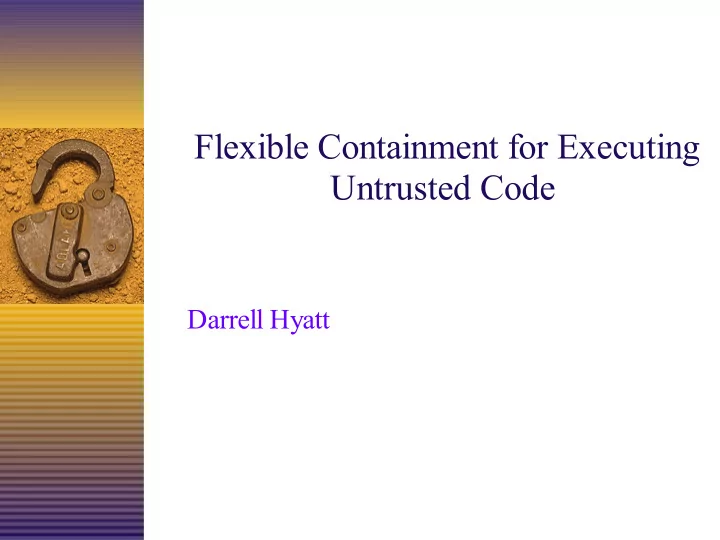

Flexible Containment for Executing Untrusted Code Darrell Hyatt
Introduction Standard security model is insufficient for security- critical applications Result – sandboxing (among other things) – Tailoring of policies to programs – Confining programs, supporting policy enforcement – Variety of options available for design • But these have both strengths & weaknesses
Sandboxing Process Process creates a new sandbox by calling sbxcreate() – Handle is returned to the process – Only the process can access the new sandbox Process configures the sandbox (including the privileges allowed) and forks; child inherits the sandbox descriptor Using sbxapply(), child applies the sandbox to itself – Forfeiture of control of all other sandbox descriptors, including the one it is in
Sandboxing Process Process (parent) retains full control of the sandbox – may launch other programs within it – may close sandbox descriptor • Eliminates parent as possible point of attack • Sandbox now unalterable by any process • Processes external to sandbox can suspend or terminate processes within the sandbox Descendants of a child inherit its sandbox Sandboxes are destroyed by the kernel through reference counting
Design Considerations for Sandboxing Organization of Privileges – Extensible – should be able to enforce new security policies as the system grows – Privileges are denied by default – Expressive – should be able to cope with fine- grained security policies • Binary – allow or deny • Quantitiative – number indicating an allowed limit (e.g. memory allocation) – Set-oriented view of privileges • Operations expressive, theory is understood, clarifying that policies are enforced
Privilege Set Operations Create union z := x || y Union w/ self x := x || y Create intersection z := x & y Intersect w/ self x := x & y Create complement z := !x Complement self x := !x Bob changes positions: Personnel → Finance – B := (B & !P) || F Bob needs access to George's non-confidential files – B := B || (G & !Gc)
Privilege Interval Lists Interval list – allow specification of intervals of values over a fixed range – Include – merge intervals – Exclude – remove interval – Intersection, Union and Complement – Query point – checks if integer exists in the interval
Privilege Sandbox Sets Sandbox sets – allow sandbox processes to perform actions in relation to other processes – A sandbox process is allowed to access processes in its own box or in descendants – Access rights may be delegated to child sandboxes – Processes not in any sandbox are considered part of the “null sandbox” – Intersections, Unions, and Complements may be computed
Design Considerations for Sandboxing Location of enforcement mechanisms – Runtime environment • Allows tailoring of security policies • Security mechanisms can be fine-grained • Only supports code that uses the runtime – Sandboxed program (e.g. Proof-carrying code) • Security mechanisms can be fine-grained • Requires binaries to be modified • Not applicable to all types of programs – User space (e.g. developer sandbox) • Easily deployed on existing systems • Process tracing is not applicable to setuid programs – Kernel • Unlimited options and most resistant to attack • Code difficult to write & debug (if accessible at all)
Design Considerations for Sandboxing Monitoring – Passive – sandbox structures consulted before requests are allowed to proceed – Active – restrictions enforced by separate processes that monitor programs as they execute Application Scope – Global – enforcing restrictions on all programs – Local – program is isolated w/in its sandbox Access Control – mandatory vs. discretionary Policy Enforcement – static vs. dynamic Sandbox Privileges – generic vs. specific Destruction – disposable vs. persistent sandboxes
Conclusions Sandbox vs. ACLs – opposing points of view – ACLs associate privileges with those requesting the use of resources – Sandboxes associate privileges with the resources themselves – Intended that the two complement one another
Recommend
More recommend